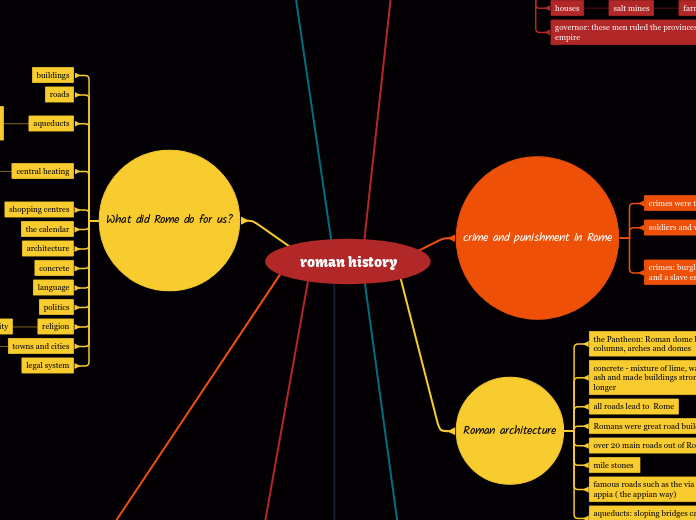roman history
life in Rome
patrician
villa
domus
mosaics: paintings done with tiles and on the floor
murals: a painting on the wall
fresco: paint on plaster
peristyle: an enclosed garden
atrium: an open room with a pond and used to impress guests
toga
stola
plebian
tunic
insulae
entertainment in Rome
colosseum
could hold 50,000 people
gladiators
gladiators that were good were often given their freedom
circus maximus/lippodrome
it held up to 250,000
theatre
baths: washing facilities
hot room
warm room
cold room
thermopolium=take away
libraries
massage rooms
restaurants
gym
slave
quarrys
houses
salt mines
farms
slops
governor: these men ruled the provinces of the empire
crime and punishment in Rome
crimes were taken from the twelve tables
worse = jury
better = magistrate
soldiers and vigils
crimes: burglary, fraud in trade, arson, murder and a slave escaping was also regarded as a crime
punishment included: crucifiction, execution, fine, gladiator, and exile
Roman architecture
the Pantheon: Roman dome built in 25BC , it had columns, arches and domes
concrete - mixture of lime, water and volcanic ash and made buildings stronger and able to last longer
all roads lead to Rome
Romans were great road builders
over 20 main roads out of Rome
mile stones
famous roads such as the via sacra and the via appia ( the appian way)
aqueducts: sloping bridges carrying water into the city
key words
Roman army
army: 3 divisions
a century: has 100 men and a centurion controls them
signifier/standard holder
a cohort: made up of ten centuries
testudo
soldiers equipment: metal helmet, scarf to protect and keep neck warm, shield was made of wood or leather with an iron rim, pila ( javelins ) and were 2 meters long 1/2 a meter long double edged sword (gladius) and a dagger.
rations reduced also for punishment
a legion: made up of five cohorts
auxiliaries: these were non - Roman
if mutiny was suspected every tenth man would be executed this was called decimation
soldiers served 20 to 25 years and were given a sum of money or a small plot of land when discharged
flogging was a punishment for disobedience
the aquila was a silver eagle and if it was taken the whole legion would be disbanded
the general: usually came from patrician background and was responsible for feeding the men
catapulta: small catapult
onager: small catapult
balista: big catapult
scorpion crossbow on a stand
rammer
training is very hard
you had to be 18 to join the army
What did Rome do for us?
buildings
roads
aqueducts
central heating
shopping centres
the calendar
architecture
concrete
language
politics
religion
the spread of christianity
catacombs - for hiding, praying and saying mass
towns and cities
cities founded by Rome: London and Paris
legal system
Roman religion
each roman family had a shrine in their homes called a larium
Jupiter - king of the Gods
Juno - queen of the Gods
Mars - God of war
Venus - God of love
Mercury - messenger of the Gods
Neptune - God of the sea
burial customs: a coin is placed in the persons mouth to pay the ferry fare to Charon
Charon: the legendary ferry man
River Styx: river to heaven
sarcophagus: coffin to cremate
Roman legacy
common language
common laws
common currency
common glass, windows, hospitals and shopping complexes
our calendar is the same as the Romans
Roman Forum
this was the main market place
the via sacra (sacred way) was a road that ran through it
